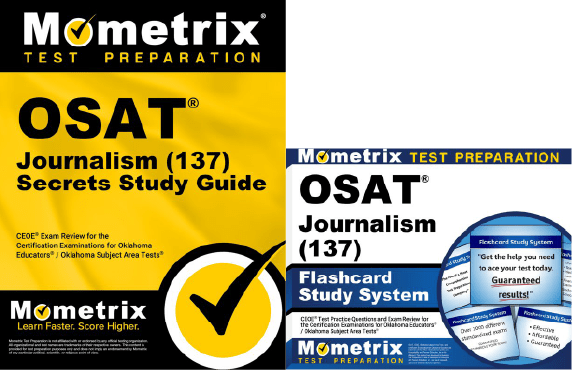If you need help studying for the OSAT Journalism test or just want some more information about what the test is like, you’ve come to the right place!
Click below to take a free OSAT Journalism practice test!
What’s on the Test?
First, let’s talk about the questions on the OSAT Journalism test. There are 81 questions in total, most being selected-response and one being constructed-response.
80 questions
Selected-response questions require you to select the correct answer from a list of options. Multiple-choice questions are the most common example, but you may also see true-or-false questions and “matching” questions, which ask you to match terms or concepts with their definitions.
Constructed-Response (CR)
1 question
The constructed-response question requires you to write your answer instead of selecting from a list of choices. Your response to this question is generally expected to be at least a few sentences, but you’ll be given specific details and instructions before you take the test.
The time limit for the exam is 4 hours. There aren’t any scheduled breaks, but you’re free to take restroom breaks as needed.
Let’s take a closer look at the different sections of the test.
1. Journalism Skills and Processes
25% of the exam
- Forms, functions, and principles of journalism
- Various information sources
- Methods for gathering and evaluating information
- Journalistic writing processes
- Preparing effective journalistic products
- Revising and editing journalistic writing
2. Foundations of Journalism
25% of the exam
- The evolution of US journalism
- The role of an independent press in a democratic society
- The rights and responsibilities of journalists
- Legal and ethics standards related to journalism
- Functions, limitations, and influences of mass media in society
- Analyzing and evaluating media content
- Media design and production
3. Advising, Instruction, and Assessment
35% of the exam
- Learning theories
- Curriculum approaches
- Classroom environments
- Forms and functions of student media
- The roles and responsibilities of a journalism adviser
- Managing student staff and media
- Content-specific journalism instruction
- The importance of professional development
4. Pedagogical Content Knowledge
15% of the exam
Then, you’ll be given specific instructions on what your written response should cover. Your finished response should be between 300 and 600 words.
How to Register
To register for the test, you’ll need to create an account on the CEOE website. Once your account has been created, you can register to take the exam.
How the Exam is Scored
The OSAT Journalism test is scored using a scaled scoring method. Here’s how it works:
Scaled Scoring
For every question you answer correctly, you get one point added to your raw score. At the end of the test, your final raw score will be converted to a scaled score.
The reason your raw score is converted to a scaled score is because everyone that takes the test is given a slightly different set of questions. Since everyone has a different arrangement of questions, and because some questions are harder than others, converting your raw score to a scaled score ensures a more even playing field.
Retaking the Exam
If you don’t get the score you want on your first try, that’s okay! You can take the exam again after a mandatory 30-day waiting period.
FAQs
How many questions are on the OSAT Journalism exam?
The exam contains 81 questions.
What is the time limit for the OSAT Journalism exam?
The exam is timed at 4 hours.
What is the passing score for the OSAT Journalism exam?
You’ll need to get a final score of at least 240 to pass.
How much does the OSAT Journalism exam cost?
The testing fee is $118.
OSAT, CEOE, Oklahoma Subject Area Tests, and Certification Examinations for Oklahoma Educators are trademarks of the Office of Educational Quality and Accountability and Pearson Education, Inc. or its affiliate(s). This page was developed by Mometrix Test Preparation. It was not developed in connection with Pearson Education, Inc., nor was it reviewed, approved or endorsed by these agencies.



 OSAT Study Guide
OSAT Study Guide OSAT Flashcards
OSAT Flashcards